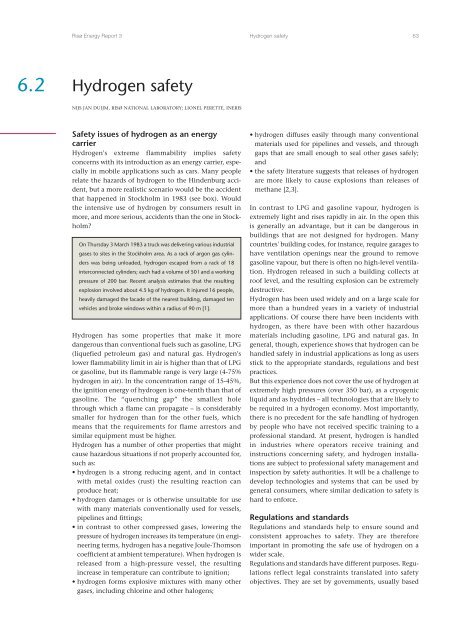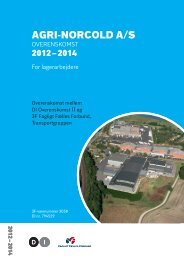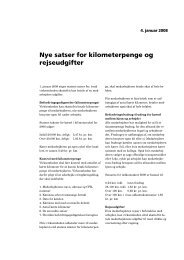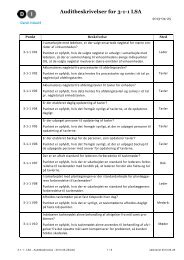Hydrogen and its competitors, 2004
Hydrogen and its competitors, 2004
Hydrogen and its competitors, 2004
You also want an ePaper? Increase the reach of your titles
YUMPU automatically turns print PDFs into web optimized ePapers that Google loves.
Risø Energy Report 3<strong>Hydrogen</strong> safety 636.2<strong>Hydrogen</strong> safetyNIJS JAN DUIJM, RISØ NATIONAL LABORATORY; LIONEL PERETTE, INERISSafety issues of hydrogen as an energycarrier<strong>Hydrogen</strong>'s extreme flammability implies safetyconcerns with <strong>its</strong> introduction as an energy carrier, especiallyin mobile applications such as cars. Many peoplerelate the hazards of hydrogen to the Hindenburg accident,but a more realistic scenario would be the accidentthat happened in Stockholm in 1983 (see box). Wouldthe intensive use of hydrogen by consumers result inmore, <strong>and</strong> more serious, accidents than the one in Stockholm?On Thursday 3 March 1983 a truck was delivering various industrialgases to sites in the Stockholm area. As a rack of argon gas cylinderswas being unloaded, hydrogen escaped from a rack of 18interconnected cylinders; each had a volume of 50 l <strong>and</strong> a workingpressure of 200 bar. Recent analysis estimates that the resultingexplosion involved about 4.5 kg of hydrogen. It injured 16 people,heavily damaged the facade of the nearest building, damaged tenvehicles <strong>and</strong> broke windows within a radius of 90 m [1].<strong>Hydrogen</strong> has some properties that make it moredangerous than conventional fuels such as gasoline, LPG(liquefied petroleum gas) <strong>and</strong> natural gas. <strong>Hydrogen</strong>'slower flammability limit in air is higher than that of LPGor gasoline, but <strong>its</strong> flammable range is very large (4-75%hydrogen in air). In the concentration range of 15-45%,the ignition energy of hydrogen is one-tenth than that ofgasoline. The “quenching gap” the smallest holethrough which a flame can propagate – is considerablysmaller for hydrogen than for the other fuels, whichmeans that the requirements for flame arrestors <strong>and</strong>similar equipment must be higher.<strong>Hydrogen</strong> has a number of other properties that mightcause hazardous situations if not properly accounted for,such as:• hydrogen is a strong reducing agent, <strong>and</strong> in contactwith metal oxides (rust) the resulting reaction canproduce heat;• hydrogen damages or is otherwise unsuitable for usewith many materials conventionally used for vessels,pipelines <strong>and</strong> fittings;• in contrast to other compressed gases, lowering thepressure of hydrogen increases <strong>its</strong> temperature (in engineeringterms, hydrogen has a negative Joule-Thomsoncoefficient at ambient temperature). When hydrogen isreleased from a high-pressure vessel, the resultingincrease in temperature can contribute to ignition;• hydrogen forms explosive mixtures with many othergases, including chlorine <strong>and</strong> other halogens;• hydrogen diffuses easily through many conventionalmaterials used for pipelines <strong>and</strong> vessels, <strong>and</strong> throughgaps that are small enough to seal other gases safely;<strong>and</strong>• the safety literature suggests that releases of hydrogenare more likely to cause explosions than releases ofmethane [2,3].In contrast to LPG <strong>and</strong> gasoline vapour, hydrogen isextremely light <strong>and</strong> rises rapidly in air. In the open thisis generally an advantage, but it can be dangerous inbuildings that are not designed for hydrogen. Manycountries' building codes, for instance, require garages tohave ventilation openings near the ground to removegasoline vapour, but there is often no high-level ventilation.<strong>Hydrogen</strong> released in such a building collects atroof level, <strong>and</strong> the resulting explosion can be extremelydestructive.<strong>Hydrogen</strong> has been used widely <strong>and</strong> on a large scale formore than a hundred years in a variety of industrialapplications. Of course there have been incidents withhydrogen, as there have been with other hazardousmaterials including gasoline, LPG <strong>and</strong> natural gas. Ingeneral, though, experience shows that hydrogen can beh<strong>and</strong>led safely in industrial applications as long as usersstick to the appropriate st<strong>and</strong>ards, regulations <strong>and</strong> bestpractices.But this experience does not cover the use of hydrogen atextremely high pressures (over 350 bar), as a cryogenicliquid <strong>and</strong> as hydrides – all technologies that are likely tobe required in a hydrogen economy. Most importantly,there is no precedent for the safe h<strong>and</strong>ling of hydrogenby people who have not received specific training to aprofessional st<strong>and</strong>ard. At present, hydrogen is h<strong>and</strong>ledin industries where operators receive training <strong>and</strong>instructions concerning safety, <strong>and</strong> hydrogen installationsare subject to professional safety management <strong>and</strong>inspection by safety authorities. It will be a challenge todevelop technologies <strong>and</strong> systems that can be used bygeneral consumers, where similar dedication to safety ishard to enforce.Regulations <strong>and</strong> st<strong>and</strong>ardsRegulations <strong>and</strong> st<strong>and</strong>ards help to ensure sound <strong>and</strong>consistent approaches to safety. They are thereforeimportant in promoting the safe use of hydrogen on awider scale.Regulations <strong>and</strong> st<strong>and</strong>ards have different purposes. Regulationsreflect legal constraints translated into safetyobjectives. They are set by governments, usually based
















